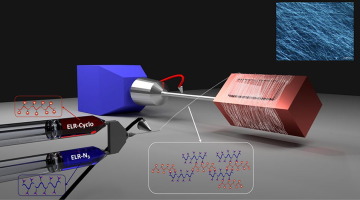Acta Biomaterialia ( IF 9.4 ) Pub Date : 2018-03-21 , DOI: 10.1016/j.actbio.2018.03.027 Israel González de Torre , Arturo Ibáñez-Fonseca , Luis Quintanilla , Matilde Alonso , José-Carlos Rodríguez-Cabello

|
Herein we present a system to obtain fibers from clickable elastin-like recombinamers (ELRs) that crosslink in situ during the electrospinning process itself, with no need for any further treatment to stabilize them. These ELR-click fibers are completely stable under in vitro conditions. A wrinkled fiber morphology is obtained. In addition to a random fiber orientation, oriented fibers with a high degree of alignment and coherence can also be obtained by using a rotational electrode. The production of multicomponent fibers means that different functionalities, such as cell-adhesion domains (RGD peptides), can be incorporated into them. In a subsequent study, two main cell lines present in the dermis and epidermis, namely keratinocytes and fibroblasts, were cultured on top of the ELR-click fibers. Adhesion, proliferation, fluorescence, immunostaining and histology studies showed the cytocompatibility of these scaffolds, thus suggesting their possible use for wound dressings in skin tissue engineering applications.
Statement of Significance
For the first time stable electrospun bioactive fibers are obtained by the in situ mixing of two “clickable” ELR components previously described by Gonzalez et al (Acta Biomaterialia 2014). This work describes an efficient system to prepare fibrous scaffolds based on peptidic polymers by electrospinning without the need of crosslinking agents that could be harmful for cells or living tissues. These bioactive fibers support cell growth due to the inclusion of RGD motifs (Staubli et al. Biomaterials 2017). Finally, the in vitro biocompatibility of the two main cell types found in the outer layers of skin, fibroblasts and keratinocytes, indicates that this system is of great interest to prepare elastic artificial skin substitutes for wound healing applications.
中文翻译:

基于多组分原位可点击弹性蛋白样重组系统的无规和定向电纺纤维,用于皮肤组织工程
本文中,我们提出了一种系统,该系统可从可点击的弹性蛋白样重组体(ELR)中获得纤维,该可重组弹性体在电纺丝过程本身中就地发生交联,而无需任何进一步的处理来稳定它们。这些ELR-click纤维在体外完全稳定条件。获得起皱的纤维形态。除了无规的纤维取向之外,还可以通过使用旋转电极获得具有高取向度和凝聚力的取向纤维。多组分纤维的生产意味着可以将不同的功能(例如细胞粘附域(RGD肽))并入其中。在随后的研究中,存在于真皮和表皮中的两种主要细胞系,即角质形成细胞和成纤维细胞,被培养在ELR-click纤维的顶部。粘附,增殖,荧光,免疫染色和组织学研究显示了这些支架的细胞相容性,因此表明它们可能在皮肤组织工程应用中用作伤口敷料。
重要声明
第一次通过原位混合Gonzalez等人(Acta Biomaterialia 2014)描述的两种“可点击的” ELR组分,获得了稳定的电纺生物活性纤维。这项工作描述了一种有效的系统,该系统可通过静电纺丝制备基于肽类聚合物的纤维支架,而无需使用可能对细胞或生物组织有害的交联剂。这些生物活性纤维由于包含RGD基序而支持细胞生长(Staubli等人Biomaterials 2017)。最后,在皮肤外层中发现的两种主要细胞类型(成纤维细胞和角质形成细胞)的体外生物相容性表明,该系统对于制备用于伤口愈合应用的弹性人造皮肤替代品非常感兴趣。











































 京公网安备 11010802027423号
京公网安备 11010802027423号